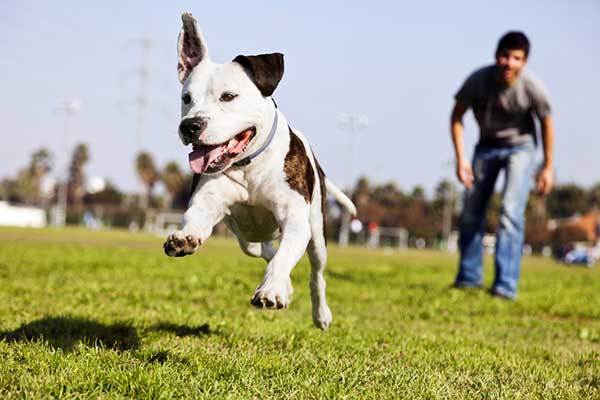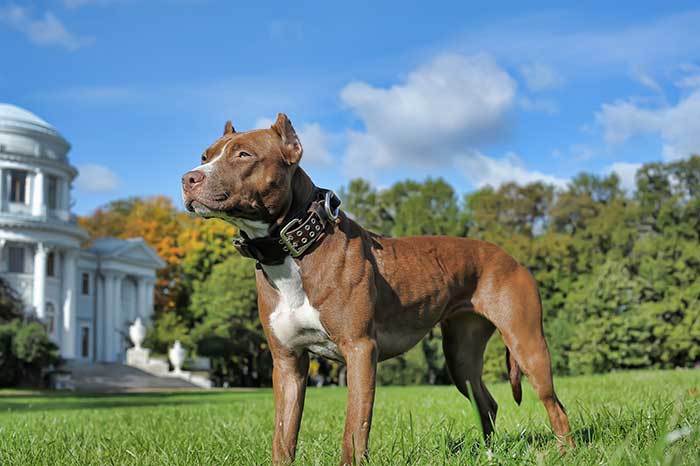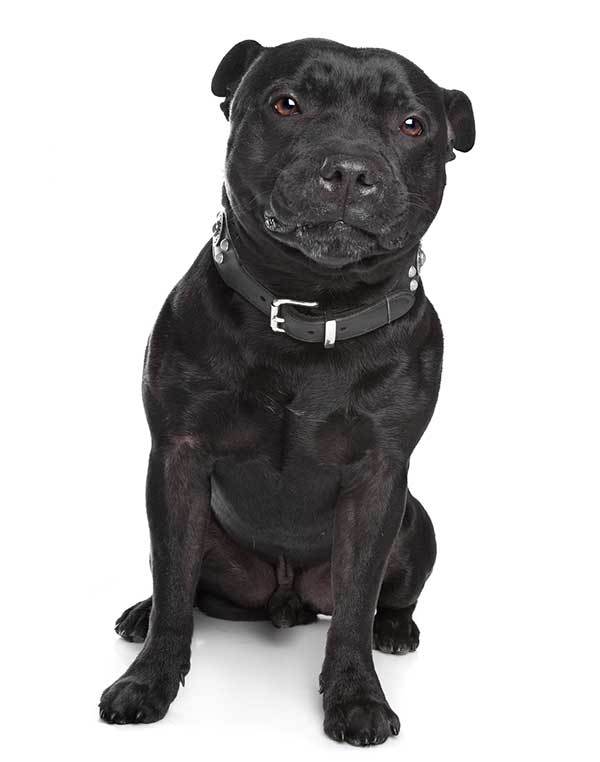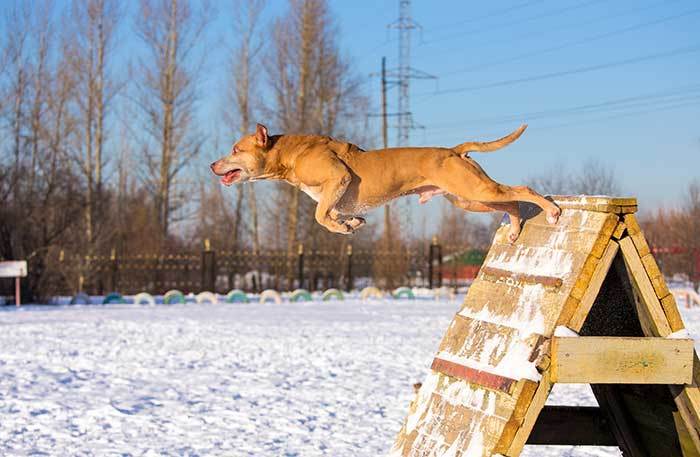As a dog owner, you have probably asked yourself this question – how fast can pitbulls run?
Well, the average speed of a pit bull is between 25 and 30 miles per hour. That works out as roughly 40.23 to 48.28 kilometers per hour. At face value, this may not seem like such an explosive speed. However, it might interest you to realize that a pit bull happens to be faster than any human on earth.
On the same breath, pit bulls aren’t really the fastest animals around, neither are they the fastest dogs.
But with such a remarkable speed and coupled with their legendary strength and tenacity, it is clear to see why these dogs have been common participants in endurance sports and activities from time immemorial.
Read on to learn more of a pit bull’s speed.
Table of Contents
Comparing Pit Bull Speed with the Speed of Other Animals
The question as to “how fast does a pitbull run?” is relative and in order to answer it adequately, it is imperative that we try and investigate the speed of some of the world’s fastest animals.
As you probably already know, the cheetah remains the fastest terrestrial animal on earth. And though the dynamics of running on land are different from what they are at sea and in the air, the cheetah still remains one of the fastest animals by all standards.
Along with its top speed of 76 mph, the cheetah is also known for its remarkable acceleration. The animal can accelerate at 10 meters per second and in just three strides, can easily achieve 40 meters per second. That’s fairly more impressive than most cars out there.

After the cheetah, the pronghorn and the springbok follow at a distant second at 55.0 mph, then wildebeests, lions, blackbucks, and hares all share a staggering speed of 50 mph.
In terms of dogs, the greyhound holds the title for the fastest dog, with speeds of up to 45 mph. It is closely followed by the African wild dog at 44 mph.
Now, looking at some of its fiercest competitors, the pitbull top speed of 25 and 30 miles per hour may not mean much.
But considering the fact that these dogs also pack extra energy, maximum agility and lots of other endurance traits, their speed could mean so much when it comes to catching up with their prey or assailants.
What Makes Dogs Run So Fast?
First and foremost, it is important to emphasize that the speed of a dog is determined by three basic factors – the dog’s breed, general health and physical composition.
Larger dog breeds tend to be faster runners than their smaller counterparts. This is for the simple reason that their legs are longer, and therefore give them larger strides.
However, this is not always the case as size is also impacted by other variables such as the dog’s weight, endurance and tenacity.
In terms of health, common logic dictates that the healthier the dog, the faster it runs. Now, let’s delve further into the physical composition of dogs in a bid to answer the question – how fast is a pitbull?
As you already expected, dogs with feet that easily grip the ground are known to be better runners. This means that as they run, there are reduced chances of sliding off their marks. Nails that offer better traction are also key in boosting a dog’s steering ability and the longer the nails, the better for the dog.

Dogs also have what we call a double-suspension gallop, a feature that enhances their speed and distance during top speeds.
Last but not least, a dog needs power and strength, not only to achieve a top speed but also to maintain it. Dogs often obtain this power from their flexible spines, deep chest, strong abdominal muscles and long loins.
But in comparing the speed of other dog breeds against that of pit bulls, you should remember that the speed of dogs are generally measured at a sprint.
What that means is that the speeds are timed when the dogs are pitted against each other in short but quick bursts. When it comes to maintaining their top speed, a dog requires both agility and stamina.
Where Does This Leave The Pitbull?
Like many other animals, a pit bull’s remarkable speed is as a result of adaptation.
Pit bulls were developed from Old English Bulldogs and Old English Terriers. The purpose was to come up with a dog that retained the two most important traits of its native parents – strength and gameness respectively.
One of pitbull’s parents – the Old English Bulldogs – were mainly bred and used in bull baiting. Basically, this was a sport where dogs were pitted against mobilized bulls and bears.
Evidently, their job description required Old English Bulldogs to be very strong as well as agile and fast. Fortunately, these traits were inherited when the Old English Bulldogs were bred with the Old English Terriers.

While pit bulls are no longer used in the sport of bull baiting following the outlawing of blood sports in 1835, the dog has continually retained the primal characteristics for which it was bred.
And since they could no longer serve the main purpose for their breeding, many dog owners began adopting pit bulls. Over the years, the dog has emerged as one of the greatest companion and therapy dogs.
Besides that, they are also now being used by law-enforcement officers as attack dogs and during illicit narcotics operations.
ALSO READ: Why Are Pit Bulls So Popular?
But what makes the pit bull such a remarkable runner?
First off, for its size, a pit bull’s legs are not that long. And coupled with their wide chests, you would be forgiven for thinking these dogs are not built for speed. However, the pit bull has quite a few redeeming qualities.
Pit bulls have very muscular shoulders. This keeps their fore limbs from tiring out when running at high speeds.
The dogs are also relatively long-nosed. This makes it easier for them to run faster and for longer without facing any serious breathing problems.
They generally weigh between 35 and 60 pounds, which is way lighter compared to other heavier dog breeds like the English Mastiff.
And as they were primarily developed for baiting sports, pit bulls have remarkable strength and agility that easily kick in when the dog is running at top speeds.
Regardless of its size, the dog can sustain its top speed for a couple of minutes, efficiently using its power and strength to keep up the pace, and its agility to steer.
Why Should You Have A Pitbull As Your Running Companion?
Though pit bulls are such excellent runners, they actually need running companions like you. T
here are so many advantages to running along with your pit bull, and this section shall highlight a few of these advantages.
First and foremost, running allows the dog to release any excess energies that could be built up within it. And as we already mentioned, these dogs pack extremely high levels of energy.
If you do not take your pit bull for frequent runs, you could be staring at serious challenges both to the dog as well as to yourself.
A pit bull that’s full of excess energy may destroy your furniture, bark excessively or even snap at your children and other pets around the house. And this holds truer for pit bull puppies that are known to be overly playful. Therefore, the best way to tire down the dog is to take it on those occasional runs.

Another reason why you should occasionally run with your pit bull is because running helps keep the dog fit. Like their human owners, inactive dogs are more susceptible to lifestyle-related diseases such as obesity, diabetes and hypertension.
Such dogs also exhibit reduced mental acuity, characterized by things like diminished sense of smell. Not to mention, too much sluggishness could cause the dog to suffer from anxiety and depression.
Last but not least, running enables you to bond with your dog. The same benefits you enjoy when hiking with your friends is the very benefit you enjoy when running with your dog.
Bonding with your pit bull is especially important if you do not spend too much time with the dog, maybe due to work commitments. Also, the dog gets to understand his locale and surroundings better.
What Activities Can Your Pit Bull Engage In?
There are many more ways to exploit your pit bull’s high speed apart from simply running together. These methods are discussed below:
1. Agility Training:
In this sport, the pit bull handler or owner gets their dog to go through a series of obstacles, including but not limited to having the pitbull running through tunnels, jumping over hurdles and weaving poles.
The strength, power and speed of the pit bull easily places it as one of the most favorite winners during such sports. Apart from possibly winning a title, you also get to tire down the dog as the two of you also bond.
2. Weight Pulling:
This is yet another important race or sport that your pit bull could engage in to have him tire down.
As the name suggests, certain amounts of weight are tied to the dog and then the dog is allowed to pull the weight over a given period of time. The muscular body of your pit bull comes in quite handy here.

3. Search and Rescue:
Pit bulls can also make perfect candidates for search and rescue missions.
In these missions, these dogs basically assist law-enforcement officers in various tasks such as sniffing out illicit substances, chasing down suspected criminals as well as searching and tracking lost people during rescue missions.
What makes the pit bull the ideal dog for search and rescue missions, apart from its speed, is its tenacity and endurance.
4. Herding:
Last but not least, you could also use your pit bull as a herding dog. And here, you can herd all manner of animals, ranging from smaller ones like goats and sheep to larger ones like cows and donkeys.
Being such an intelligent dog, the pit bull will effectively use the skills he has learnt over the years to carefully herd your cattle.
The dog will effectively keep your cattle out of potentially-dangerous places as well as prohibited patches, while also leading them home at the end of every herding session.
Conclusion
So, are pit bulls fast?
Yes, pit bulls are some of the fastest dog breeds out there. Apart from their speed, the dog also has lots of features that make it able to sustain its top speed for longer. But these dogs are also very playful.
As a dog owner, it is your duty to help them channel their energies into useful activities, some of which have been highlighted in this post.



